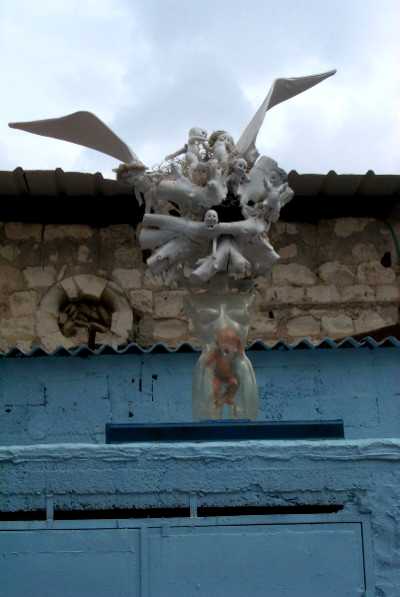|
In
Haifa, A Walk Among Faiths
|
|
by
Valerie Thomas
|
When Victor Hajjar looks out the front of his fish store in Haifa, a hilly seaside town in northern Israel, he sees art. Across the street, a life-size lucite torso with a chain-bound baby inside and a clump of white, winged tree limbs sprouting from its neck has been rigged to the top of a garage. Kitty-corner, a painted Israeli flag, on which a mirror has replaced the Star of David, hangs over a shop sign, and a few paces down a mosaic made from spent bullets and marbles adorns a pitted cement wall.
Mr. Hajjar has his own interpretation of the torso piece.
"That's a fetus in the stomach," he said. "The baby will be born, but we don't know what it will be a Muslim, a Christian, a Jew. We know what we want our own children to be, but the angels on top don't care. They love everyone."
 |
The art is part of an outdoor exhibit called "Coexistence Walk", a feature in an annual festival sponsored by the Beit Hagogen Center, an organization devoted to peaceful coexistence between Israeli Muslims, Christians and Jews.
Each fall, for the past three years, two hundred artists, representing all three faiths, have installed their pieces throughout a neighborhood where both Arabs and Jews live, on the sides of abandoned buildings, atop people's homes, attached to iron balconies, or jutting out of vacant lots. Over-sized yellow footsteps painted on the sidewalks lead from piece to piece, down alley-ways, around corners and up steep steps, as if Alice had stumbled into a whimsical treasure hunt.
In a country in which tension between cultures and faiths simmers just beneath the surface, and often erupts into full-scale violence, Haifa has long been a city where coexistence seems possible, where living together in peace is practice more than theory. Dr. Motti Peri of Beit Hagogen explained the city has made coexistence between Arabs and Jews a first priority, both in business and in the way that neighborhoods are mixed. He attributed the city's success to its laid back quality and predominantly secular population.
"It's not Jerusalem, where everything is holy, too holy. The stones are holy. Here there's more cement, less stones," he said.
This year's "Coexistence Walk" went up in November, one month after the latest Intifada began, and although fewer tourists have come to see the art, Peri feels that for local residents the exhibit came at just the right moment.
"I don't believe in culture solving problems, I believe in economy, in business," he said, "but this November I saw the power of this show, it was right on time, it contributed to normalization."
Ali Abue-elhija, a postman, disagreed.
"It's not the place to put them," he said, standing a few feet from a drain- pipe that had been worked into a mural as a tree trunk.
"This community is very poor, we need something to change the neighborhood, the standard of living, not just art," he said.
But overall the residents in the neighborhood seem to have no problem with the art. None of the pieces have been vandalized since they went up despite the fact that all of them are outdoors, exposed to the public day and night. At the end of a small Haifa cul-de-sac, a carpenter stopped sanding a table to reflect on an egg-like concrete sculpture perched on a hill nearby.
"I have no understanding of the egg," he said. "It's a circle in an egg, who cares?"
Of course, living with art and liking it are two different things.